In the process of removing the engine, you will come across a number of steps
which call for the removal of a separate component or system, such as "disconnect
the exhaust system'' or "remove the radiator.'' In most instances, a detailed
removal procedure can be found elsewhere in this manual.
It is virtually impossible to list each individual wire and hose which must
be disconnected, simply because so many different model and engine combinations
have been manufactured. Careful observation and common sense are the best possible
approaches to any repair procedure.
Removal and installation of the engine can be made easier if you follow these
basic points:
- If you have to drain any of the fluids, use a suitable container.
- Always tag any wires or hoses and, if possible, the components they came
from before disconnecting them.
- Because there are so many bolts and fasteners involved, store and label
the retainers from components separately in muffin pans, jars or coffee cans.
This will prevent confusion during installation.
- After unbolting the transmission or transaxle, always make sure it is properly
supported.
- If it is necessary to disconnect the air conditioning system, have this
service performed by a qualified technician using a recovery/recycling station.
If the system does not have to be disconnected, unbolt the compressor and
set it aside.
- When unbolting the engine mounts, always make sure the engine is properly
supported. When removing the engine, make sure that any lifting devices are
properly attached to the engine. It is recommended that if your engine is
supplied with lifting hooks, your lifting apparatus be attached to them.
- Lift the engine from its compartment slowly, checking that no hoses, wires
or other components are still connected.
- After the engine is clear of the compartment, place it on an engine stand
or workbench.
- After the engine has been removed, you can perform a partial or full teardown
of the engine using the procedures outlined in this manual.
NOTE: On vehicles equipped with air conditioning, it is vital
to refer to Section 1 prior to performing this procedure.
- On models equipped with air conditioning, have the system discharged and
evacuated by a MVAC, EPA-certified, automotive technician. Have the A/C compressor
removed from the engine.
- Disconnect the negative battery cable.
- Remove the hood.
- Remove the air intake tube and the accessory drive belt(s).
CAUTION
When draining engine coolant, keep in mind that cats and dogs are attracted
to ethylene glycol antifreeze and could drink any that is left in an uncovered
container or in puddles on the ground. This will prove fatal in sufficient
quantity. Always drain coolant into a sealable container. Coolant should
be reused unless it is contaminated or is several years old.
- Drain the cooling system.
- Remove the cooling fan, shroud, radiator and all cooling system hoses.
- On all models, label and detach all engine wiring and vacuum hoses which
will interfere with engine removal. Position the wire harness out of the way.
- On all models, the engine wiring harness is removed with the engine. Only
label and detach the harness connectors from components which must be removed.
Also unplug the harness at the main bulkhead (firewall), transmission and
PCM connections.
- Unbolt the power steering pump from the engine and position it out of the
way. The fluid lines do not have to be disconnected.
- Detach the accelerator and transmission control cables from the throttle
body, and the control cables' mounting bracket from the engine.
- Release fuel system pressure, then disconnect the fuel supply and return
lines from the engine.
- Remove any remaining mounting brackets and/or drive belt tensioners.
- Raise the vehicle and safely support it on jackstands.
CAUTION
The EPA warns that prolonged contact with used engine oil may cause a number
of skin disorders, including cancer! You should make every effort to minimize
your exposure to used engine oil. Protective gloves should be worn when
changing the oil. Wash your hands and any other exposed skin areas as soon
as possible after exposure to used engine oil. Soap and water, or waterless
hand cleaner should be used.
- Drain the engine oil and remove the oil filter.
- Detach the exhaust system from the exhaust manifolds.
- Remove the starter motor and starter motor wiring from the engine.
- Label and detach any under vehicle engine wiring, which will interfere with
engine removal.
- On vehicles equipped with automatic transmissions, matchmark the position
of the torque converter to the flywheel. Remove the bolts.
- Remove all of the engine-to-transmission bolts.
NOTE: All 2.3L, 2.5L, 3.0L (Pick-up) and 4.0L engines use
a plate between the engine and the transmission. Some models may have a
smaller, removable, flywheel/flexplate
- If equipped, remove the transmission oil cooler line retainers-to-engine
bolts.
| Fig. 1: Engine mounting points for 2.3L engines
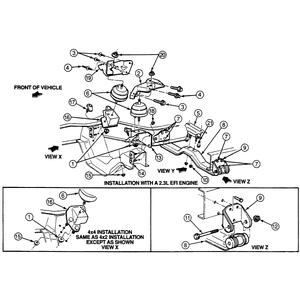
|
| Fig. 2: Engine mounting points for 3.0L engines (B
Series Pick-up)
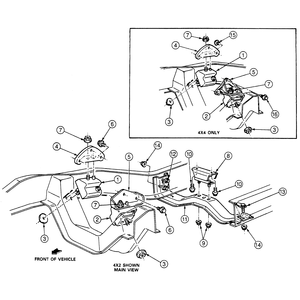
|
| Fig. 3: Engine mounting points for 4.0L engines
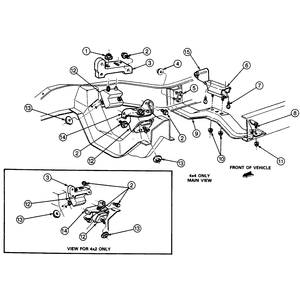
|
| Fig. 4: Engine damper mounting for 4.0L engines
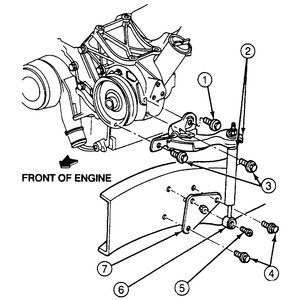
|
| Fig. 5: Engine damper mounting for MPV models
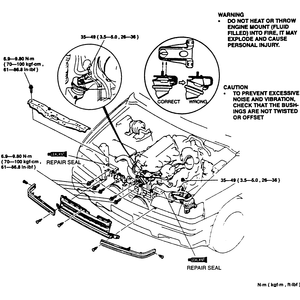
|
- Remove the front engine support insulator-to-crossmember retaining fasteners.
- If equipped, remove the engine damper mounting bracket from the engine.
The bracket may use two TORX® bolts for the lower mounting points.
- Partially lower the vehicle and support it with jackstands in the new position.
- Support the transmission with a floor jack.
- Using an engine crane or hoist, lift the engine out of the vehicle. Be sure
to lift the engine slowly and check often that nothing (such as wires, hoses,
etc.) will cause the engine to hang up on the vehicle.
- At this point, the engine can be installed on an engine stand.
To install:
NOTE: Lightly oil all bolts and stud threads, except those
specifying special sealant, prior to installation.
- Using the hoist or engine crane, slowly and carefully position the engine
in the vehicle. Make sure the exhaust manifolds are properly aligned with
the exhaust pipes.
- Align the engine to the transmission and install two engine-to-transmission
bolts.
NOTE: Seat the left-hand side, front engine support insulator
locating pin prior to the right-hand side, front engine support insulator.
- Lower the engine onto the front engine support insulators.
- Detach the engine crane or hoist from the engine.
- Remove the floor jack from beneath the transmission fluid pan.
- Tighten the two installed engine-to-transmission bolts, then raise and securely
support the vehicle on jackstands.
- Install and tighten the remaining engine-to-transmission bolts.
- The remainder of installation is the reverse of the removal procedure. Be
sure to tighten the fasteners to the values presented in the torque specification
chart.
WARNING
Do NOT start the engine without first filling it with the proper type and
amount of clean engine oil, and installing a new oil filter. Otherwise,
severe engine damage will result.
- Fill the crankcase with the proper type and quantity of engine oil. If necessary,
adjust the transmission and/or throttle linkage.
- Install the air intake duct assembly.
- Connect the negative battery cable, then fill and bleed the cooling system.
- Bring the engine to normal operating temperature, then check for leaks.
- Stop the engine and check all fluid levels.
- Install the hood, aligning the marks that were made during removal.
- If equipped, have the A/C system properly leak-tested, evacuated and charged
by a MVAC-trained, EPA-certified, automotive technician.



